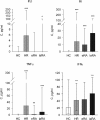A transient peak of infections during onset of rheumatoid arthritis: a 10-year prospective cohort study
- PMID: 25180052
- PMCID: PMC4156809
- DOI: 10.1136/bmjopen-2014-005254
A transient peak of infections during onset of rheumatoid arthritis: a 10-year prospective cohort study
Abstract
Objectives: The role of infection in rheumatoid arthritis (RA) has not been determined. We aimed to document the infectious burden and some aspects of antibacterial immunity in a large and prospective cohort study of RA patients in the early and late stages of the disease and in their relatives predisposed to RA.
Setting: Clinical and laboratory examination of all individuals enrolled in the study was performed in the Republican Clinical Hospital, Kazan, Russia.
Participants: 376 patients with RA, 251 healthy first-degree relatives and 227 healthy controls without a family history of autoimmune disease (all females) were examined twice annually over more than 10 years.
Primary and secondary outcome measures: The following parameters were investigated: type, duration and frequency of infections, bacterial colonisation and serum levels of IgG to bacteria, serum levels of total Ig, plasma cytokine levels, granulocyte reactive oxygen species production, lysozyme activity and phagocytosis.
Results: There were no significant differences in infection rate between healthy controls (median 14 days/year) and RA patients (13). However, infection rates were higher (p<0.001) in healthy relatives (53) and early stage patients (62), which groups also showed heavy bacterial skin colonisation. In contrast, late stage patients had fewer infection days (12; p<0.001) than healthy controls, although bacterial colonisation was still heavy. Phagocyte function and antibacterial antibody generation, together with compensatory cytokine production, were observed to be subnormal in the healthy relatives as well as in RA patients.
Conclusions: We observed a marked increase in overall infections at the time of RA onset, and signs of a defective antibacterial defence mechanism, contrasting with fewer infections in the late RA stage. It can be speculated that frequent early infections initiate a compensatory immune hyper-reactivity which reduces the infection load while stimulating the development of RA in predisposed individuals.
Keywords: IMMUNOLOGY.
Published by the BMJ Publishing Group Limited. For permission to use (where not already granted under a licence) please go to http://group.bmj.com/group/rights-licensing/permissions.
Figures





References
-
- Kay A. Infection in rheumatoid arthritis. Lancet 1968;290:152
-
- Leirisalo-Repi M. Early arthritis and infection. Curr Opin Rheum 2005;17:433–9 - PubMed
-
- Ogrendik M, Hakgruder A, Keser N. Treatment of rheumatoid arthritis with ornidazole. A randomized, double-blind, placebo-controlled study. Rheumatology 2006;45:636–7 - PubMed
-
- Vanderbroucke JP, Kaaks R, Valkenburg HA, et al. Frequency of infections among rheumatoid arthritis patients, before and after disease onset. Arthritis Rheum 1987;30:810–13 - PubMed
-
- Doran MF, Crowson CS, Pond GR, et al. Frequency of infection in patients with rheumatoid arthritis compared with controls. Arthritis Rheum 2002;46:2287–93 - PubMed
Publication types
MeSH terms
Substances
LinkOut - more resources
Full Text Sources
Other Literature Sources
Medical
Molecular Biology Databases
